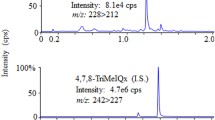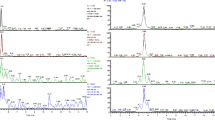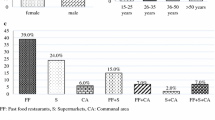Abstract
Objective: To compare indicators of heterocyclic amine (HCA) exposure with HCA concentrations in home-cooked meat samples.
Methods: Pan-fried hamburger and steak samples were obtained from individuals stating a preference for medium, well done and very well done meat. Concentrations of DiMeIQx, IFP, MeIQx and PhIP were determined by HPLC.
Results: HCA concentrations at the three doneness levels were not significantly different using the participants' self-reported doneness preference to categorize samples. Using doneness levels determined at the time the meat was cooked and photograph analysis to categorize samples, HCA concentrations increased with doneness level and significant differences were observed between the very well done and lower doneness levels. When assigned to doneness levels by photograph analysis, mean concentrations (ng/g cooked meat) of DiMeIQx, IFP, MeIQx, and PhIP were 0.18, 0.16, 0.65 and 0.47 in well done hamburger and 0.61, 0.74, 1.88 and 2.04 in very well done hamburger. In steak, mean concentrations were 0.24, 0.10, 0.79 and 0.59 in well done steak and 0.45, 0.14, 1.87 and 0.62 in very well done steak.
Conclusions: HCA levels in home-cooked meat samples were significantly different when samples were visually classified for doneness, but not when self-reported doneness preference was used to classify doneness.
Similar content being viewed by others
References
Knize MG, Dolbeare FA, Carroll KL, Moore DH, Felton JS (1994) Effect of cooking time and temperature on the heterocyclic amine content of fried beef patties. Food Chem Toxicol 32: 595–603.
Sinha R, Rothman N, Brown ED, et al. (1995) High concentrations of the carcinogen 2-amino-1-methyl-6-phenylimidazo [4,5-b]pyridine (PhIP) occur in chicken but are dependent on the cooking method. Cancer Res 54: 6154–6159.
Skog K, Steineck G, Augustsson K, Jagerstad M (1995) Effect of cooking temperature on the formation of heterocyclic amines in fried meat products and pan residues. Carcinogenesis 16: 861–867.
Sinha R, Rothman N, Salmon CP, et al. (1998) Heterocyclic amine content of beef cooked by different methods to varying degrees of doneness and gravy made from meat drippings. Food Chem Toxicol 36: 279–287.
Sinha R, Knize MG, Salmon CP, et al. (1998) Heterocyclic amine content of pork products cooked by different methods and to varying degrees of doneness. Food Chem Toxicol 36: 289–297.
De Stefani E, Ronco A, Mendilaharsu M, Guidobono M, Deneo-Pellegrini H (1997) Meat intake, heterocyclic amines, and risk of breast cancer: a case-control study in Uruguay. Cancer Epidemiol Biomarkers Prev 6: 15–24.
Probst-Hensch NM, Sinha R, Longnecker MP, et al. (1997) Meat preparation and colorectal adenomas in a large sigmoidoscopy-based case-control study in California (United States). Cancer Causes Control 8: 175–183.
Ward MH, Sinha R, Heineman EF, et al. (1997) Risk of adenocarcinoma of the stomach and esophagus with meat cooking method and doneness preference. Int J Cancer 71: 14–19.
Zheng W, Gustafson DR, Sinha R, et al. (1998) Well-done meat intake and the risk of breast cancer. J Natl Cancer Inst 90: 1724–1729.
Sinha R, Kulldor. M, Curtin J, Brown CC, Alavanja MCR, Swanson CA (1998) Fried, well-done red meat and risk of lung cancer in women (United States). Cancer Causes Control 9: 621–630.
Sinha R, Chow WH, Kulldor. M, et al. (1999) Well-done, grilled red meat increases the risk of colorectal adenomas. Cancer Res 59: 4320–4324.
Ambrosone CB, Freudenheim JL, Sinha R, et al. (1998) Breast cancer risk, meat consumption and N-Acetyltransferase (NAT2) genetic polymorphisms. Int J Cancer 75: 825–830.
Kampman E, Slattery ML, Bigler J, et al. (1999) Meat consumption, genetic susceptibility, and colon cancer risk: a United States multicenter case-control study. Cancer Epidemiol Biomarkers Prev 8: 15–24.
Augustsson K, Skog K, Jagerstad M, Dickman PW, Steineck G (1999) Dietary heterocyclic amines and cancer of the colon, rectum, bladder, and kidney: a population based study. Lancet 353: 703–707.
Alavanja MC, Sandler DP, McMaster SB, et al. (1996) The Agricultural Health Study. Environ Health Perspect 104: 362–369.
Knize MG, Sinha R, Rothman N, et al. (1995) Heterocyclic amine content in fast-food meat products. Food Chem Toxicol 33: 545–551.
Pais P, Tanga MJ, Salmon CP, Knize MG (2000) Formation of the mutagen IFP in model systems and detection in restaurant meats. J Agric Food Chem 48: 1721–1726.
Horwitz W (1982) Evaluation of analytical methods used for regulation of foods and drugs. Anal Chem 54: 67A–76A.
Norrish AE, Ferguson LR, Knize MG, Felton JS, Sharpe SJ, Jackson RT (1999) Heterocyclic amine content of cooked meat and risk of prostate cancer. J Natl Cancer Inst 90: 1724–1729.
Author information
Authors and Affiliations
Rights and permissions
About this article
Cite this article
Keating, G.A., Sinha, R., Layton, D. et al. Comparison of heterocyclic amine levels in home-cooked meats with exposure indicators (United States). Cancer Causes Control 11, 731–739 (2000). https://doi.org/10.1023/A:1008935407971
Issue Date:
DOI: https://doi.org/10.1023/A:1008935407971




